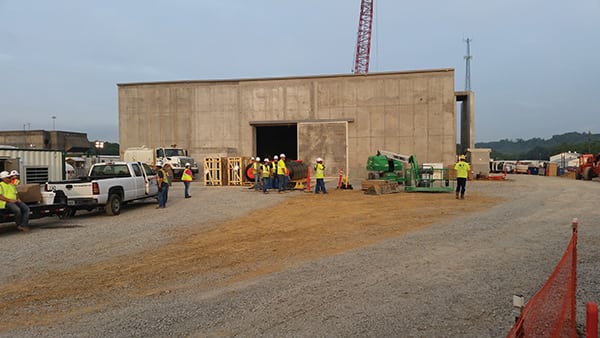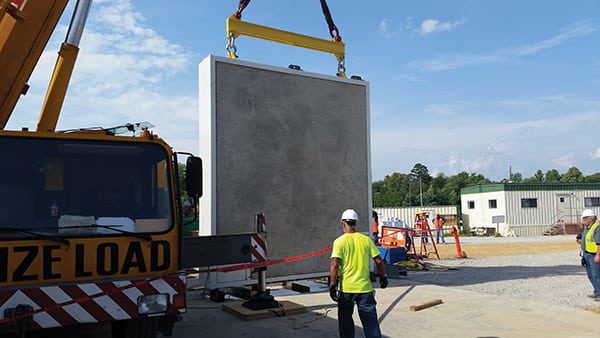New Disaster Preparedness Approaches for Nuclear Plants
To ensure that its nuclear plants do not meet the same fate as those damaged and destroyed by the March 2011 events at the Fukushima Daiichi plant—should they be hit by similarly severe natural disasters—Tennessee Valley Authority (TVA) is using multiple new approaches to enhance safety.
First Installation of New Spent Fuel Pool Instrumentation
Spent fuel pools are storage pools for spent, or used, nuclear fuel from a nuclear reactor. As part of an industrywide response to lessons learned from the Japanese accident, all U.S. utilities are required by the Nuclear Regulatory Commission (NRC) to install spent fuel pool level instrumentation at their nuclear power plants.
In July, Westinghouse Electric Co. announced that it had completed the first successful installation at a U.S. nuclear plant site of a spent fuel pool level instrumentation system meeting the NRC requirements. The system was installed at the Watts Bar Nuclear Plant, which is owned and operated by TVA.
In the event of an emergency that causes an extended loss of AC power at the plant, the new spent fuel pool instrumentation system provides plant operators with a way to monitor the water level in the pool to verify that the used fuel remains covered by water and appropriately cooled.
Westinghouse joined with a leading global manufacturer of state-of-the-art level instrumentation to supply the technology, which is provided by a guided-wave-radar sensor. This wide-range spent fuel pool instrumentation system leverages robust technology to address NRC requirements, providing a reliable indication of the spent fuel pool level.
“Essentially, it’s a sonar device,” TVA explained to POWER. “It sends a signal, which bounces back when the density changes—meaning the difference between liquid and air—and it can be measured remotely to make sure the cooling water remains at the necessary depth in the event of an emergency.”
Westinghouse has contracts to deliver more than 90 spent fuel pool instrumentation system solutions in the U.S. While the system at Watts Bar has completed all testing and has been declared operational, additional instrumentation systems at other locations are in various stages of installation and testing.
At Watts Bar, the instrumentation receives its backup power, as do all other critical systems, from a series of backup generators. One is on the top of the building housing the spent fuel pool. If that fails, another backup generator is onsite, and others can be brought in within a few hours of placing a call for assistance.
“Declaration of the Westinghouse spent fuel pool instrumentation system as functional at Watts Bar represents a significant milestone for Westinghouse and the nuclear energy industry,” said David Howell, senior vice president for Westinghouse Automation and Field Services.
Backup Plans
In July, TVA also completed the first operational “flex” equipment storage building in the world (Figure 1). The building is designed to store equipment needed as protection against extreme natural disasters like the event that occurred in Fukushima. In this case, the structure houses backup generators, pumps, and other materials, which can be used to replace equipment damaged during an event. Designed to withstand 360-mph winds, the building has 18-inch thick concrete walls. The rolling tornado-missile-shield door (Figure 2)—also 18 inches thick—is 14 feet wide and 16 feet tall.
 |
| 1. Built to last. The flex equipment storage building is designed to withstand natural disasters of the most severe kind. Courtesy: TVA |
And if that weren’t enough, two new nuclear regional response centers opened this year to ensure backup equipment is available even following unthinkable disasters that disable multiple nuclear plants at the same time. The $40 million centers—located in the Phoenix, Ariz., and Memphis, Tenn., metropolitan areas—are stocked with portable generators, water pumps, lighting, and other equipment that can be rapidly deployed in the event of an emergency. The equipment, which is preloaded onto trailers, can be delivered to any nuclear power plant in the U.S. within 24 hours of a request.
Useful Redundancy
With all of the redundant backup systems, TVA believes its new spent fuel pool instrumentation system can keep running off of the available power indefinitely.
—Edited by Aaron Larson, a POWER associate editor (@AaronL_Power, @POWERmagazine).
